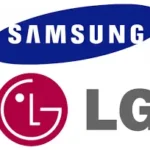In the third quarter of this year (July to September), Korean giants Samsung Electronics and LG Electronics collectively accounted for 30% of TVs shipped in the global market. Despite a downturn in global TV market demand, the two companies maintained their dominance, securing the first and second positions in sales market share. This was attributed to their strategic emphasis on ultra-large and high-definition premium TVs.
Market research firm Omdia’s third-quarter report, released on the 21st, revealed that Samsung Electronics led with a 29.9% market share, marking a 2.4 percentage point increase from the same period last year (27.5%). The likelihood of Samsung achieving the top spot in the industry for the 18th consecutive year has risen. LG Electronics retained its second position with a sales share of 16.7%, while China’s TCL followed at 10.6%, Hisense at 9%, and Japan’s Sony at 6.3%.
In terms of quantity, a total of 50,556,000 units were shipped in Q3, with Samsung Electronics and LG Electronics collectively contributing 30% to the total. Samsung Electronics, in particular, increased its sales share to 62%, with a notable surge in the premium product market priced over $2,500. It maintained a leading market share of 34.8% in the 75-inch or larger ultra-large TV segment.
LG Electronics showcased strength in the organic light-emitting diode (OLED) TV market, shipping 2,036,800 units in Q1 to Q3 2023. With a market share of 55%, LG is poised to secure the top position in the OLED TV market for the 11th consecutive year, driven by a strategic focus on OLED as the next-generation premium market. In the 75-inch and larger OLED TV market, LG’s market share reached close to 60% in the third quarter. In comparison, Samsung Electronics, with approximately 620,000 OLED TVs shipped in the same period, is gradually expanding its market share.
Omdia’s estimates suggest that cumulative shipments in the global TV market for the first to third quarters of this year were consistent with the previous year at 143,277,000 units. However, with the industry grappling with a recession, forecasts predict that cumulative shipments may dip below 200 million units by year-end.



